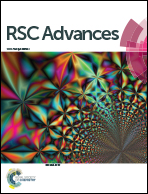Copolymer chain formation of 2-oxazolines by in situ1H-NMR spectroscopy: dependence of sequential composition on substituent structure and monomer ratios†
Abstract
In situ 1H NMR characterization of copolymerization reactions of various 2-oxazoline monomers at different molar ratios offers detailed insight into the build-up and composition of the polymer chains. Various 2-oxazolines were copolymerized in one single solvent, butyronitrile, with 2-dec-9′-enyl-2-oxazoline, where the double bond allows for post-polymerization modification and can function as a crosslinking unit to form polymer networks. The types of the monomers and their molar ratios in the feed have a strong effect on the microstructure of the forming copolymer chains. Copolymers comprising 2-dec-9′-enyl-2-oxazoline and either 2-ethyl-, 2-isopropyl-, 2-butyl-, 2-heptyl, 2-nonyl- or 2-phenyl-2-oxazoline, show significant differences in sequential structure of copolymers ranging from block to gradient and random ordering of the monomer units. 1H NMR was found to be a powerful tool to uncover detailed oxazoline copolymerization kinetics and evolution of chain composition.



 Please wait while we load your content...
Please wait while we load your content...